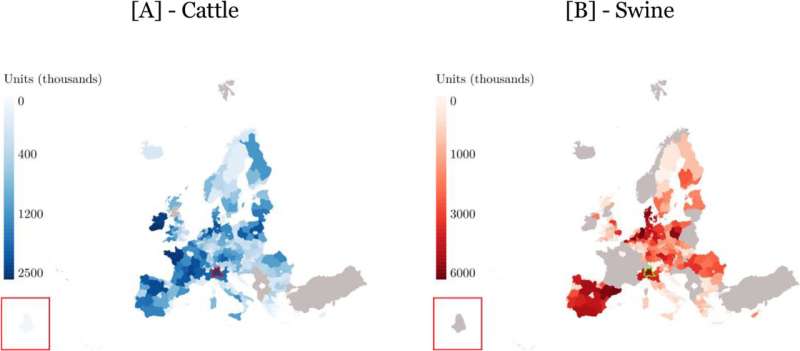This article has been reviewed according to Science X's editorial process and policies. Editors have highlighted the following attributes while ensuring the content's credibility:
fact-checked
proofread
Livestock farming is responsible for up to a quarter of air pollution in Lombardy region: Study

Agricultural activities and livestock farming are key contributors to the concentrations of hazardous pollutants for health and the environment in the atmosphere, but the potential action in these sectors is often overlooked in public debate.
The recent pollution alarm in Northern Italy has brought attention to the Lombardy region, one of the most critical areas in Europe in terms of air quality. A new study titled "Exploring the impact of livestock on air quality: A deep dive into Ammonia and particulate matter in Lombardy," conducted with the participation of CMCC authors, provides a framework for studying the impact of farming on air pollution in the area and supports the need for integrated policies in the agricultural sector.
The work is published in the journal Environmental Impact Assessment Review.
The study was conducted in the context of the INHALE project (Impact on humaN Health of Agriculture and Livestock Emissions), coordinated by Università Bocconi and carried out in partnership with the CMCC Foundation and Legambiente Lombardia. Scientists studied the extent to which emissions from agriculture contribute to high concentrations of particulate matter, and consequently, may lead to a related increase in health risk for the population in Lombardy. The research shows the need for pollution reduction policies not to ignore emissions from agro-livestock sources (ammonia), while at the same time acting on traffic pollutants (NOx).
"The Po Valley is infamously known for the poor quality of the air its inhabitants breathe," says Jacopo Lunghi from Bocconi University and CMCC, lead author of the paper. "Its record levels of particulate matter, especially during winter, make it one of the most polluted areas in Europe. Investigating the sources of such unhealthy air is vital to decrease pollution and increase the well-being of individuals through effective policy action."
The contribution of ammonia (NH3) emissions to the levels of particulate matter recorded in the Po Valley is substantial, and agriculture, especially the management of livestock manure and the use of fertilizers, is the main source. Animal husbandry operations are responsible for large releases of ammonia, a gaseous compound that serves as a precursor in secondary particle formation.
From reactions with other compounds, such as sulfur oxides (SOx) and nitrogen oxides (NOx), ammonia contributes to a major part of the inorganic composition of PM2.5. This explains why air pollution from livestock farms is associated with airway obstruction diseases and severe pneumonia.
Specifically, an increase of 1,000 units in livestock triggers a corresponding daily increase in ammonia and particulate matter concentrations in Lombardy quantified at 0.26 and 0.29 μg/m3 for bovines (about 2% and 1% of the respective daily averages) and 0.01 and 0.04 μg/m3 for swine. The study also suggests that bovine and swine farming could account for up to 25% of local pollution exposure.
The paper contributes by establishing a necessary step to evaluate the nature of the direct correlation between changes in livestock levels and the impact on human health due to air pollution. The use of causal inference methods is a novel approach to this type of analysis.
"The Po Valley suffers from an unfortunate combination of unfavorable orographic conditions, high population density and high industrial and agricultural intensity" affirms CMCC researcher Lara Aleluia Reis. "Much is being done to mitigate the power and the transport sector and to some extent also the residential sector. Agriculture, more specifically the sector of livestock, cannot be left aside and must also be included in more stringent air pollution mitigation policies."
Maurizio Malpede from University of Verona says, "Understanding the environmental impacts of intensive livestock farming can pave the way for a less polluted environment. Our research can help us develop sustainable farming practices that not only minimize environmental harm but also mitigate public health risks.
"By optimizing resource use and reducing waste, we can ensure more efficient and sustainable production systems. Additionally, our research findings can guide policy decisions to protect ecosystems and public health while increasing consumer awareness about the consequences of their dietary choices, which can contribute to global efforts to mitigate climate change."
More information: Jacopo Lunghi et al, Exploring the impact of livestock on air quality: A deep dive into Ammonia and particulate matter in Lombardy, Environmental Impact Assessment Review (2024). DOI: 10.1016/j.eiar.2024.107456
Provided by CMCC Foundation—Euro-Mediterranean Center on Climate Change





















